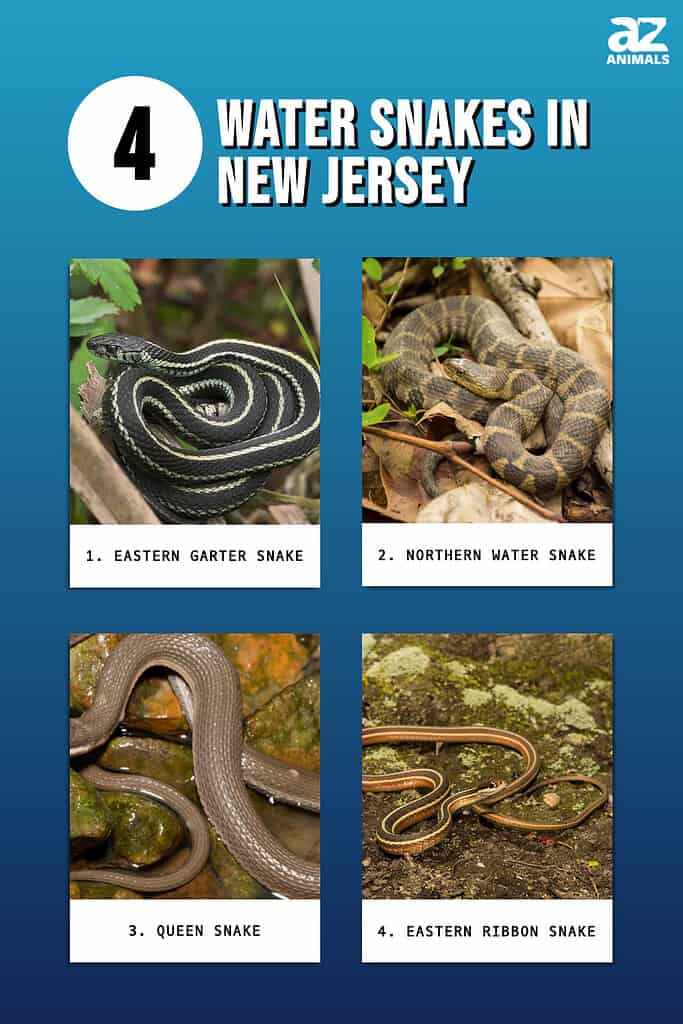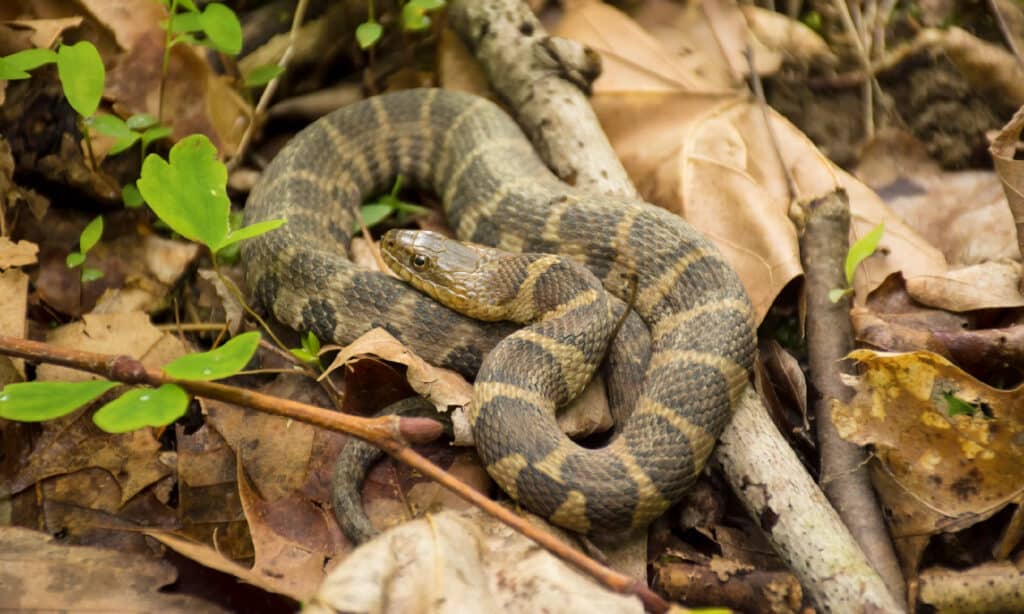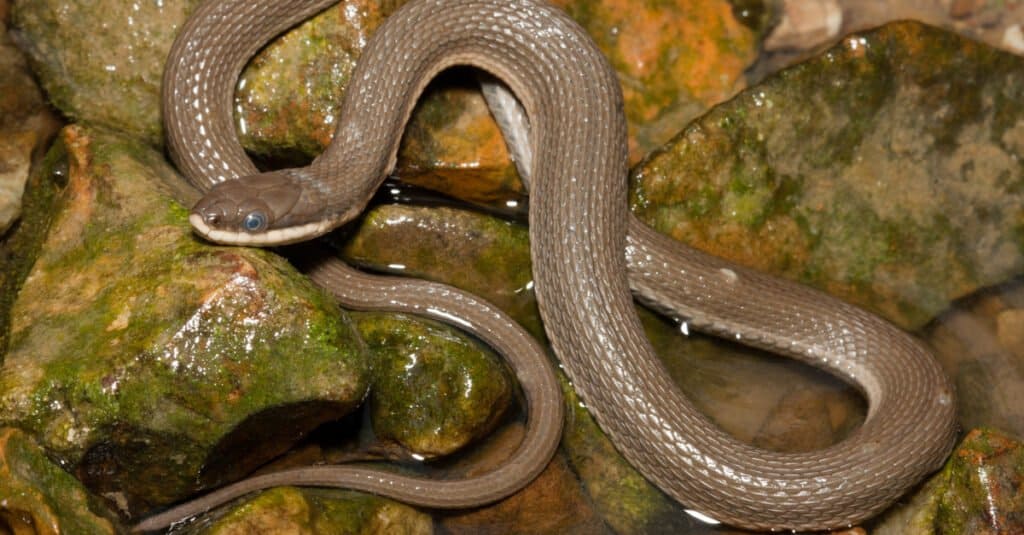Despite being a small and densely populated state, New Jersey houses numerous animals that live in a wide variety of locations. In fact, with borders that include the Atlantic Ocean and the Delaware River, it’s understandable that there are a lot of aquatic animals in the state — including snakes. New Jersey has 22 species of snakes and four of these lurk in the water. Three of them occur statewide, while one is extremely rare. So, let’s find out which are the water snakes in New Jersey!

1. Eastern Garter Snake (Thamnophis sirtalis sirtalis)

Eastern garter snakes produce venom in their saliva which they chew into their prey.
©iStock.com/rkhalil
We’ll begin with the eastern garter snake which is a subspecies of the common garter snake. Eastern garter snakes occur statewide. They live in a variety of habitats, although frequently near water — such as stream edges, wet woodlands, rivers, ditches, and swamps. They mainly prey on fish, amphibians, worms, and slugs, but also sometimes prey on small mammals and birds. Eastern garter snakes are not truly venomous. However, they do possess a mild type of venom which is produced in the Durvenoy’s gland. Although this is not true venom they do use it to slow down and incapacitate their prey. However, they don’t have fangs to inject it with, so it is produced in their saliva and they chew it into their prey instead.
Eastern garter snakes are 18 to 26 inches long and are usually olive green, brown, or black. They have a yellow or cream-colored stripe down their back and one on each side on scale rows two and three. They also often have either red or black spots between their stripes. Their bellies are yellow to pale green and feature a row of black spots.
2. Northern Water Snake (Nerodia sipedon)

Northern water snakes can be aggressive if they are disturbed and can deliver a painful bite with their sharp teeth
©iStock.com/IcemanJ
As a member of the Nerodia genus, the northern water snake is the only true water snake in the state. They are large snakes that can reach lengths of almost five feet. They also have brown-colored bodies which are covered with a series of darker crossbands and blotches. Sometimes the ground color can be particularly dark. This, combined with the dark markings, can make the snake appear to be almost completely black. The markings consist of broad crossbands in the neck and body region which then become blotches towards the tail. Although cottonmouths don’t live in New Jersey, northern water snakes are often mistaken for them in other states where their ranges overlap.
Northern water snakes occur statewide in New Jersey and live in most freshwater habitats — from swamps to rivers. They can often be seen in the water, but they also spend time out of the water basking on rocks close to the shore. They mainly prey on fish and amphibians, but will also eat some small mammals if the opportunity arises. Northern water snakes are not venomous and are not typically dangerous to humans. However, they can bite if they are threatened or provoked and as they have sharp teeth they can inflict a painful wound. The saliva of northern water snakes has an anti-coagulant in it, meaning that wounds caused by them often bleed a lot.
3. Queen Snake (Regina septemvittata)

Queen snakes have thick plate-like scales on their head and chin to protect them while they are hunting between rocks.
©Nathan A Shepard/Shutterstock.com
The next water snake in New Jersey is the queen snake which is a snake that is uniquely adapted to its surroundings. Queen snakes inhabit rocky-bottomed rivers and streams. They have a distinctly flattened head which helps them to reach underneath rocks while searching for prey. They also have a series of large, thick scales on the top of their head and underneath their chin to protect them from the sharp stones. Queen snakes are 15 to 24 inches long and have tan to dark brown bodies. They also have a yellow stripe on the lower side of their body and darker stripes on the upper side. However, the upper stripes tend to fade as the snake ages, so may not appear to be present. Queen snakes also have a cream or yellow belly with brown stripes.
Queen snakes prey predominantly on crayfish. However, factors such as water pollution and the erosion of the stream banks have affected populations of crayfish in New Jersey. As a result, queen snakes are a state-endangered species and only occur in limited locations, primarily along the Delaware River.
4. Eastern Ribbon Snake (Thamnophis sauritus sauritus)

Eastern ribbon snakes typically inhabit slow-moving water, such as swamps and streams.
©Jay Ondreicka/Shutterstock.com
The final snake is the eastern ribbon snake which is a subspecies of the ribbon snake. Eastern ribbon snakes have slender bodies and can be anything from seven to 33 inches long. They typically have dark brown to black bodies with three yellow stripes — one along the center of their back and one along each side of their body. They also usually have a greenish-white belly and a long tail that is approximately one-third of their total length.
Eastern ribbon snakes live across the entire state and can be found in habitats close to a permanent source of water. However, they tend to prefer slower-moving water, such as swamps and streams. Instead of submerging their bodies in the water, eastern ribbon snakes tend to glide across the top. They are quick to flee into the water at the first sign of danger. However, they rarely bite if they are handled. They are mainly diurnal and are active between April and October.
The photo featured at the top of this post is © iStock.com/sdbower
Discover the "Monster" Snake 5X Bigger than an Anaconda
Every day A-Z Animals sends out some of the most incredible facts in the world from our free newsletter. Want to discover the 10 most beautiful snakes in the world, a "snake island" where you're never more than 3 feet from danger, or a "monster" snake 5X larger than an anaconda? Then sign up right now and you'll start receiving our daily newsletter absolutely free.
Thank you for reading! Have some feedback for us? Contact the AZ Animals editorial team.






